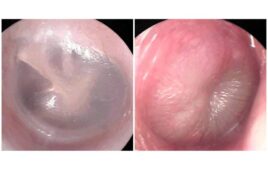
[Image from Wikipedia]
CheXpert, developed by researchers at Stanford University, is an automated chest X-ray interpretation model that uses artificial intelligence to analyze X-ray images take in emergency departments.
A study found that the AI system could accurately identify key findings in chest X-rays of patients in the emergency room. The quick diagnosis allowed physicians to accurately confirm and start a treatment plan for pneumonia more quickly than with current clinical practice.
“CheXpert is going to be faster and as accurate as radiologists viewing the studies. It’s an exciting new way of thinking about diagnosing and treating patients to provide the very best care possible,” principal investigator on the study Nathan Dean said in a news release.
The CheXpert model was developed by the Stanford Machine Learning Group. It used 188,000 chest imaging studies to create a model to ID pneumonia in X-rays. The model was fine-tuned for the Intermountain Healthcare study by reading 6,973 more images from the hospitals’ emergency departments.
“We’ve been developing a deep learning algorithm that can automatically detect pneumonia and related findings in chest X-rays,” researcher Jeremy Irvin said. “In this initial study, we’ve demonstrated the algorithm’s potential by validating it on patients in the emergency departments at Intermountain Healthcare. Our hope is that the algorithm can improve the quality of pneumonia care at Intermountain, from improving diagnostic accuracy to reducing time to diagnosis.”
Patients who are suspected of having pneumonia in emergency departments receive chest X-rays. The images are created in a quick process, but having them read can be time-consuming, according to the researchers. The process can take 20 minutes or more, which can delay the start of antibiotics to fight the infection.
Radiologists’ reports at intermountain emergency departments are run through the Cerner Natural Language Processing. The Natural Language Processing (NLP) feeds the information to an electronic clinical decision support tool known as the ePNa. Although, most emergency departments aren’t equipped with ePNa and the CheXpert model could give clinicians that information directly.
“Using the CheXpert system, we found the interpretation time was very swift and the accuracy of the report to be very high,” Dean said.
Intermountain radiologists categorized chest images from 461 patients as “likely,” “likely-uncertain,” “unlikely-uncertain” or “unlikely” to have pneumonia. They also identified images that they believed had pneumonia in multiple parts of the lungs and if the patients had parapneumonic effusion, or fluid build-up between the lungs and chest cavity.
CheXpert outperformed the current system radiologists use to create radiology reports, according to the researchers. It also identified pneumonia in less than 10 seconds, compared to the 20 minutes it traditionally takes from NLP.
The researchers say that they hope to use the CheXpert model live in emergency departments starting this fall in Intermountain Healthcare hospitals.
The research was funded by the Intermountain Research and Medical Foundation.




